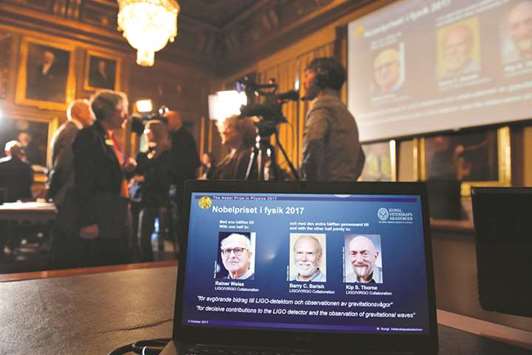US astrophysicists Barry Barish, Kip Thorne, and Rainer Weiss were awarded the Nobel Physics Prize yesterday for the discovery of gravitational waves, offering a sneak peek at the Universe’s very beginnings.
Predicted by Albert Einstein a century ago as part of his theory of general relativity, gravitational waves are “ripples” in space-time – the theoretical fabric of the cosmos.
They are the aftermath of violent galactic events, such as colliding black holes or imploding massive stars, and can reveal events that took place billions of years ago.
The first detection of gravitational waves happened in September 2015 at the US-based Laser Interferometer Gravitational-wave Observatory (LIGO), where the three Nobel laureates worked.
“Their discovery shook the world,” said Goran K Hansson, the head of the Swedish Royal Academy of Sciences which selects the Nobel laureates.
Announced in February 2016 to great excitement in the scientific community, the discovery was hailed as the historic culmination of decades of research.
In 1984, Thorne, now 77, and Weiss, 85, co-created LIGO at the prestigious California Institute of Technology (Caltech), which has taken home 18 Nobels since the prizes were first awarded in 1901.
Barish, 81, joined the project in 1994 and helped bring it to completion.
LIGO is now a collaboration between more than 1,000 researchers from 20 countries.
The 2015 observation was of two black holes smashing into each other some 1.3bn light-years away.
“Although the signal was extremely weak when it reached Earth, it is already promising a revolution in astrophysics,” the Nobel academy said. “Gravitational waves are an entirely new way of following the most violent events in space and testing the limits of our knowledge.”
In an interview on the Nobel prize website, Thorne said that the discovery will enable scientists to see an “enormous number of things” in coming decades.
“We will see neutron stars collide, tear each other apart, we will see black holes tearing neutron stars apart, we will see spinning neutron stars, pulsars ... we’ll be exploring basically the birth of the universe.”
Gravitational waves are minuscule, and near-undetectable because they interact very weakly with matter and travel through the universe at the speed of light unimpeded.
The ripples emitted by a pair of merging black holes, for example, would stretch a one-million-kilometre (621,000-mile) ruler on Earth by less than the size of an atom.
Since 2015, the enigmatic ripples have been detected three more times: twice by LIGO and once by the Virgo detector located at the European Gravitational Observatory (EGO) in Cascina, Italy.
Weiss was awarded half the prize, which comes with 9mn Swedish kronor (about $1.1mn or €940,000), while Barish and Thorne shared the rest.

The names of Rainer Weiss, Barry C Barish, and Kip S Thorne are displayed on the screen during the announcement of the winners of the Nobel Prize in physics 2017, in Stockholm.
